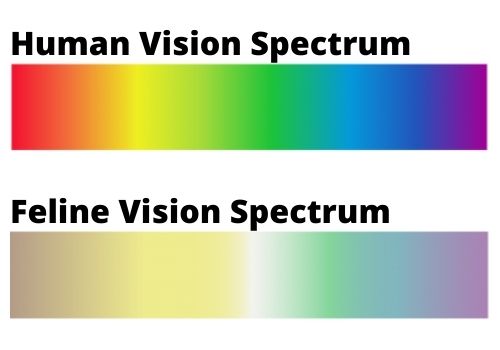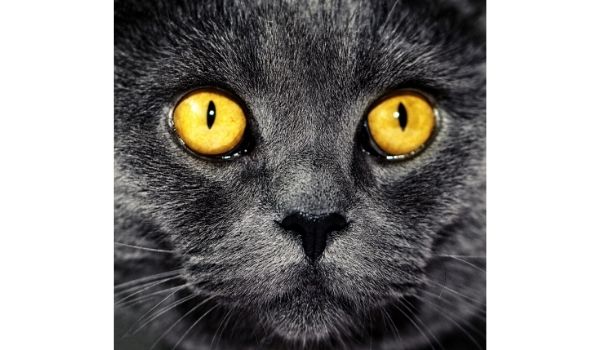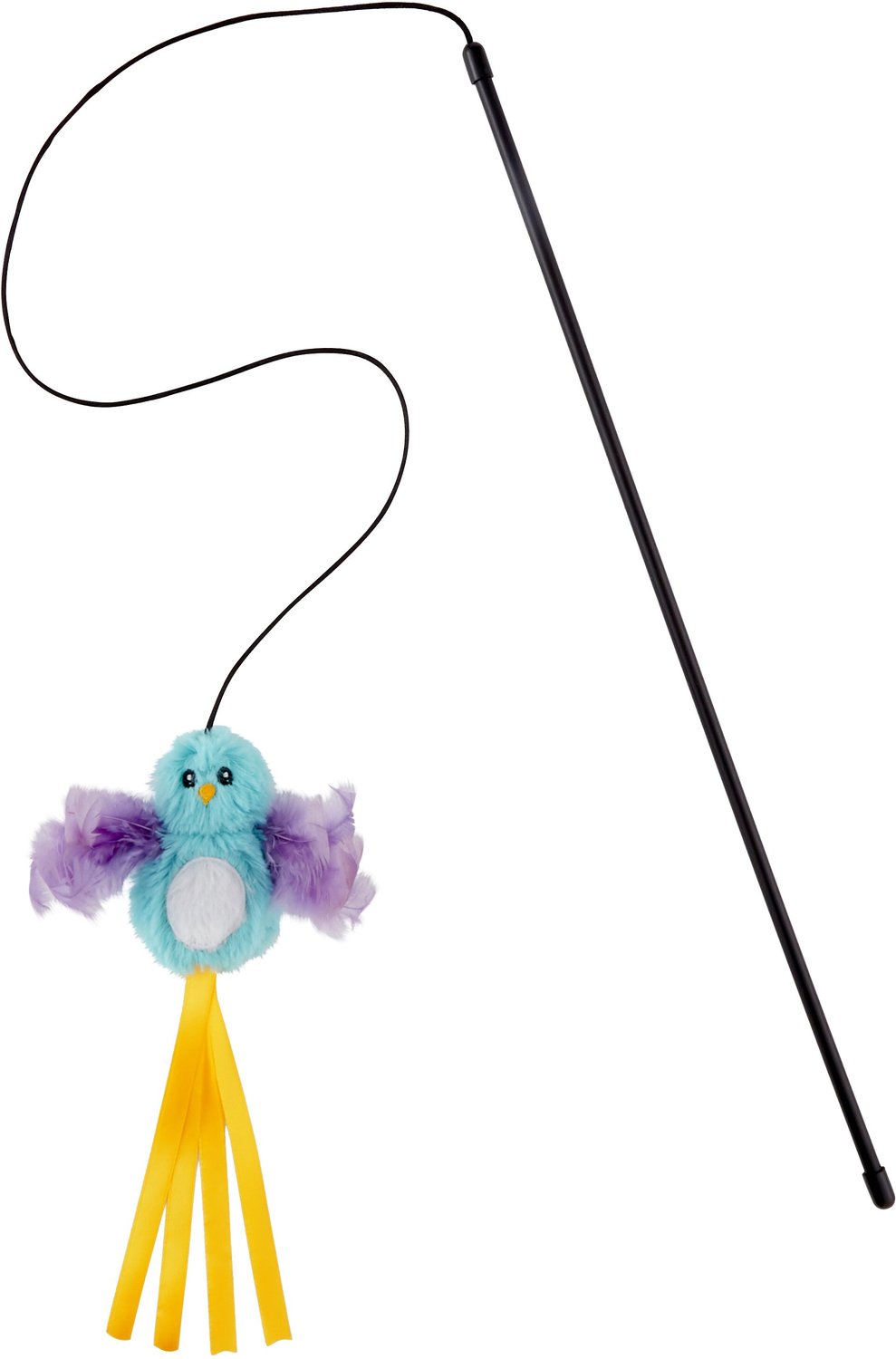Like most cat owners, you probably have a basket full of colorful cat toys. But do you ever wonder if your feline fella can even see colors? Are cats color blind like dogs? Do cats only see in black and white? How do cats see the world around them?
Do Cats See in Black and White?
It is widely believed that both cats and dogs see in black and white. But that’s not the case. While it is true that cats cannot perceive the rainbow’s colors just like humans, it does not appear entirely black and white to them. Actually, both cats and dogs can see colors but quite differently from humans. Where exactly does the difference lie? How is cat vision different from human vision?
Cat Vision Vs. Human Vision
We do not know exactly how the world looks through cats’ eyes. But with years of research, we have been able to get an idea of how the cats’ eyes work. With input from veterinarians and ophthalmologists, Nickolay Lamm, an artist, has presented his idea of how the world might look through cats’ eyes. He did this project for MyDeals.com.
| Cat Vision | Human Vision |
|---|---|
| Cats have 10 times fewer cones than humans and thus cannot clearly differentiate between colors | Humans have more cones and can clearly differentiate between all colors of the rainbow |
| A higher concentration of light rods equip cats with superior night vision and motion detection | A lower concentration of light rods explains the bad human night vision as compared to cats |
| Cats are short-sighted and can only see clearly within a range of 20 feet | Humans can see clearly between 100 to 200 feet |
| Cats have a 200° wide view | The human eye offers only a 180° wide view |
| Cats have about 50% larger cornea than that humans | Humans have smaller cornea as compared to cats |
| Cats have superior night vision—they require only one-sixth of the amount of light required by the human eye to see clearly | Human night vision is inferior when compared to felines |

Both Cats And Humans are Trichromatic
Humans are trichromatic. We have three different cone cells in our eyes, letting us identify red, green, and blue combinations. Like humans, cats are also trichromatic. But despite being trichromatic, cats’ vision is quite different from humans. This is because of the variation in the numbers of light rods and cones present in human and cat’s eyes.

Cats Have Fewer Cones And More Light Rods
According to VCA hospital, cats have 10 times fewer cones than humans. The cats’ inability to differentiate between colors is due to the lower number of cones in their retina.
The higher number of rods compensates for the lower number of cones in cats. Where cones have the duty of identifying colors, rods detect light and motion. The higher number of rods gives cats an edge over humans when it comes to night vision or seeing in dim light.

Cats Are Short-Sighted
In addition to the difference in the number of cones and rods, cats are also short-sighted. They can only see objects clearly within a range of 20 feet. In contrast, humans can clearly see as far as 100 to 200 feet.

Cats Have a Wider Field of View
Another difference between cat vision and human vision is in their peripheral vision. The human eye is designed to offer only a 180-degree wide view; cats’ eyes are programmed to enjoy a 200-degree wide view.

Are Cats Color Blind?
No Cats are not color blind—meaning they do not see the world in black and white.
Cats’ vision is similar to color-blind humans. They do not perceive the full range of colors. Even the colors that cats tend to perceive are not “truly” appreciated by them—they appear to be washed out because of the lower concentration of cones in cat eyes.
As discussed earlier, cats have very few cones as compared to humans. This is the reason that many people tend to wrongly believe that cats are color blind. But cats are not color blind—they see colors but are not as vibrant as humans do.

Which Colors Can Cats See?
Cats are not color-blind, but it does not mean that they can appreciate the colors of the rainbow just like humans. It also does not mean that they see in black and white; they do see colors. But there is still no clear answer to “what colors can cats see?”
While some scientists and vets believe that cats can only see shades of blue and grey, others argue that cats can also perceive yellow and green. However, it is confirmed that they cannot perceive pink or red hues.

Besides wondering about the colors cats can see, watching your cats roam around and be active at dawn and dusk, you may wonder whether cats can see in the dark. If yes, how well can cats see in the dark? Are cats nocturnal?
Do Cats Have Night Vision?
Not exactly! But cats do have better night vision as compared to human beings. The higher number of light rods, larger cornea, and reflective tapetum lucidum present in cats’ eyes help them see better in dim light. That said, cats cannot see in pitch-black darkness.

Are Cats Nocturnal?
No! Cats are not nocturnal. Are they diurnal? No, they are not diurnal either. Actually, cats are crepuscular beings. This means that their circadian rhythms dictate them to sleep throughout the night and day and be active at dawn and dusk. Before domestication, when cats were in the wild and had to forage and hunt for food, they used to hunt at dawn or dusk. Today, despite having been domesticated for ages, they have still kept their hunting instincts as well as circadian rhythms intact.

Can Cats See in the Dark?
Yes, cats can see in the dark. But they cannot see in complete darkness; they need some level of light—dim light—to be able to see. They see well in dim lights, during twilight—at dawn and dusk. They only need one-sixth of the amount of light as compared to humans to be able to see. This means that cats can see well with the moon out or a really dim-lit lamp in the room.
How Do Cats See in the Dark?
Noticing your cats easily swerving through a cluttered room without hitting anything, you may wonder how cats can see in the dark when they cannot even differentiate between colors, and the whole world appears blurry to them.
Let’s discuss how cats can see in the dark—dim light?
As discussed above, cats have a higher number of light rods in their eyes, which plays a role in enabling them to see in the dark. These light rods are responsible for detecting light. They also make cats detect motion in dim lights. Cats’ ability to see in the dark is furthered by the presence of a unique material, tapetum lucidum, in their eyes.
According to Dr. Cynthia Powell, tapetum lucidum acts as a mirror and reflects the light passing through the retina, brightening the view for them. Tapetum lucidum is also responsible for making cat eyes glow in the dark when light falls upon them.

Moreover, cats also have elliptical pupils that allow them to capture the maximum light, bettering their night vision. It is due to all these qualities that cats’ night vision is twice as efficient as dogs.
Combined with the night vision, higher motion-detecting capabilities in low light make dawn and dusk perfect hunting times for cats.
Can Cats See in Ultraviolet?
Yes, cats can see in ultraviolet light.
While the human eye is designed to block ultraviolet (UV) light, the cat eye is programmed to see in UV light. UV light passes through the UV-transparent lenses of these animals and hits the retina, where it is converted into nerve signals and sent to the visual system in the brain. As per research, in addition to cats, many other animals such as dogs, ferrets, and hedgehogs can see in UV light.
Are Blue-Eyed Cats Blind?
Have you heard this rumor? How about this one: “white cats are prone to blindness.” Well, the good news is that none of these is ‘entirely’ true. But the sad news is that having a white coat increases the chances of deafness in cats, especially when they have blue eyes. According to research, 17 to 22 percent of white cats with non-blue colored eyes are born deaf. The incidence of deafness jumps to 40 percent when white cats have one blue eye. And the probability of deafness shoots up to 65 to 85 percent when white cats have both blue-colored eyes. So, if your ball of cotton is a cat with blue eyes, there is a huge probability that she might be deaf. We hope she is not. That said, with great care, you can help your cat live a normal and happy life.
Did You Know?
At the time of birth, all kittens have blue eyes. Their eyes color transitions into their adult eye color as they age.
What Does Cat Colorblindness Mean for You and Your Cat?
Knowing your cat cannot perceive the vibrant colors of the rainbow, you might feel sorry for your cat. But don’t. Their superior night vision compensates for their impairment. However, it would help if you considered which colors a cat can see while shopping for cat toys and other products for your cat.
You should only buy those products with colors that a cat can easily see, such as blue, grey, and yellow. Similarly, you can avoid buying products featuring red or pink colors.
Tips to Stimulate Your Cat’s Vision
As feline vision is designed to make them the ultimate hunter, who can catch even the tiniest of movement and use their strong sense of smell to reach their rewards, you can plan fun activities that will help stimulate the hunting instincts of your feline friend.
- Cat laser pointer toys are a great way to provide mental stimulation, burn some pent-up energy, and stimulate cat vision. Stalking, chasing, and pouncing at the laser point is a lot of fun for cats.
- When you are away, keep the TV on. Play videos for your cat to provide visual and auditory stimulation to the cat. If your cat loves stalking birds, you can get her a cat window perch.
- Unless you have a couch potato, most cats love to work (hunt) for their food. So, instead of pouring cat food into its bowl, hide it in multiple places in the house. Using her strong sense of smell, your cat will get to each hidden morsel.
- You can also get treat-dispensing cat toys and puzzles to provide mental stimulation to your kitty.
Are Cats Color Blind?
No! Cats are not colorblind. They do see colors but not as clearly as humans do. While it is widely believed that cats can only see blue and gray, many think that cats can also perceive yellow and a little bit of green. That said, it is substantiated that cats cannot see red or pink shades. So, while shopping for your kitty, you should avoid items featuring red or pink shades.
Now that you have learned are cats color blind or not, maybe you want to take a look at can dogs see color.







